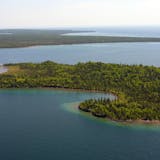Minnesota's great basswood and sugar maple forests have been cut into smaller and smaller pockets during the last 150 years. The "Big Woods" that once ruled the state are long gone, fractured into hundreds of parks and reserves.
There are still remnants of the old forest that have never been logged, or at least haven't been logged in a century. But they're separated from each other by highways, homes and farms, and it's unclear which plants and animals are still able to reproduce and which are on their way to extinction.
Foresters with the University of Minnesota are starting a long-overdue count, aiming to identify each plant in what is left of the Big Woods of south-central Minnesota. During the next two years, they'll find out where some of the rarer plants, such as trilliums, are still living and see if there are ways to bring plant life back.
"We're starting with plants because if the plants go, then pollinators go, and the whole ecosystem goes," said Lee Frelich, director of the U's Center for Forest Ecology. "Think of a city with all these big buildings that are empty of people. You can still have old trees surviving, but with nothing else, it's all degraded."
The Big Woods is what the explorers first called the shady forests dominated by elm, basswood, red oak and sugar maples that once lined the edge of Minnesota's prairies. Before European settlement, the woods covered an estimated 1.3 million acres in what is now the Twin Cities and south-central Minnesota. There are roughly 28,000 acres of it left, or about 2%, Frelich said.
While those remnants have been carefully protected in state parks and science reserves, many species may need more space to regenerate.
Many of the plants rely on insects to pollinate. When the forests are separated from each other by farms and subdivisions, it can be difficult if not impossible for those pollinators to make it from one patch to another, Frelich said.
The major stresses on the forests have also been getting worse over the last few decades, he said.



